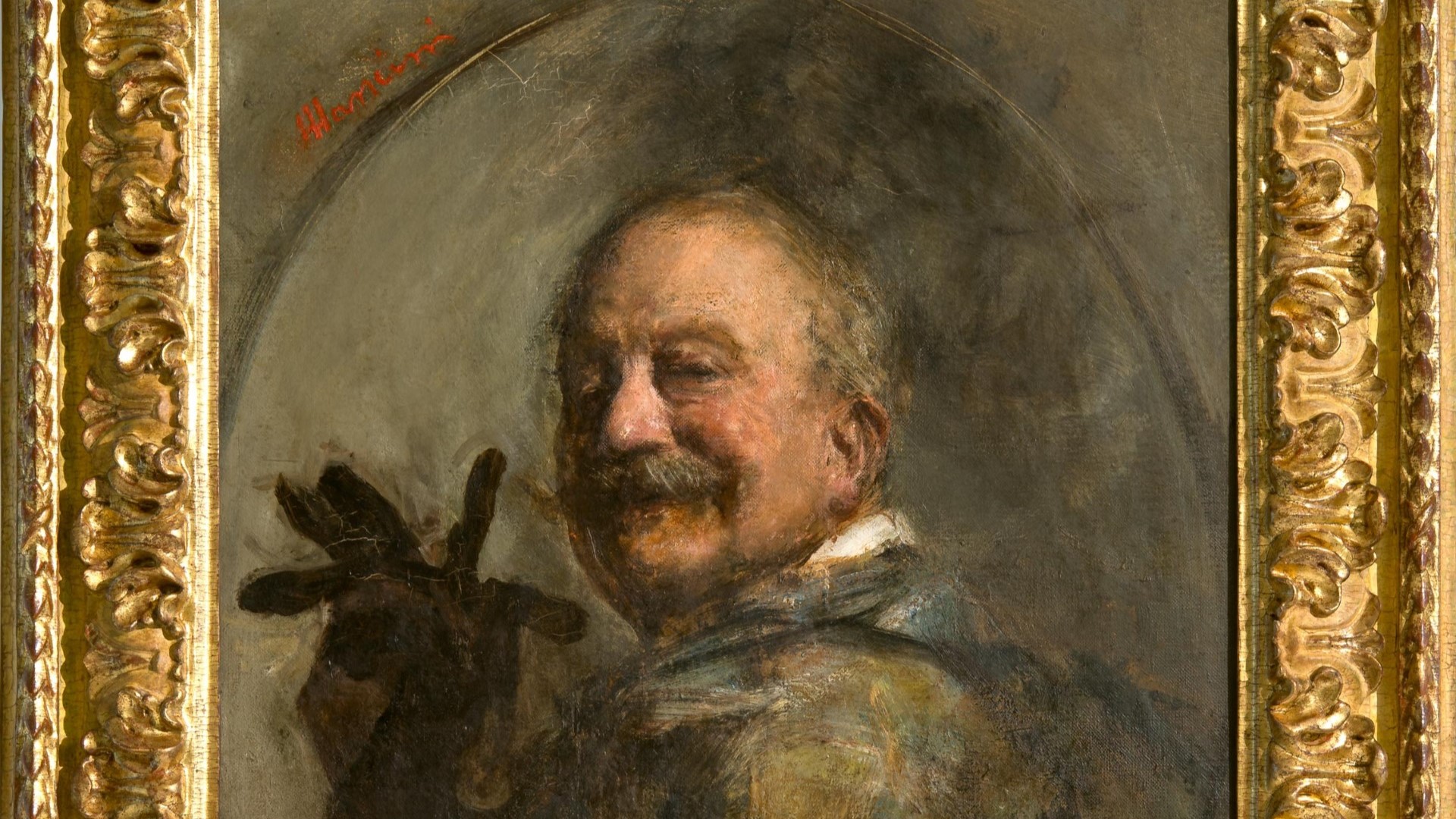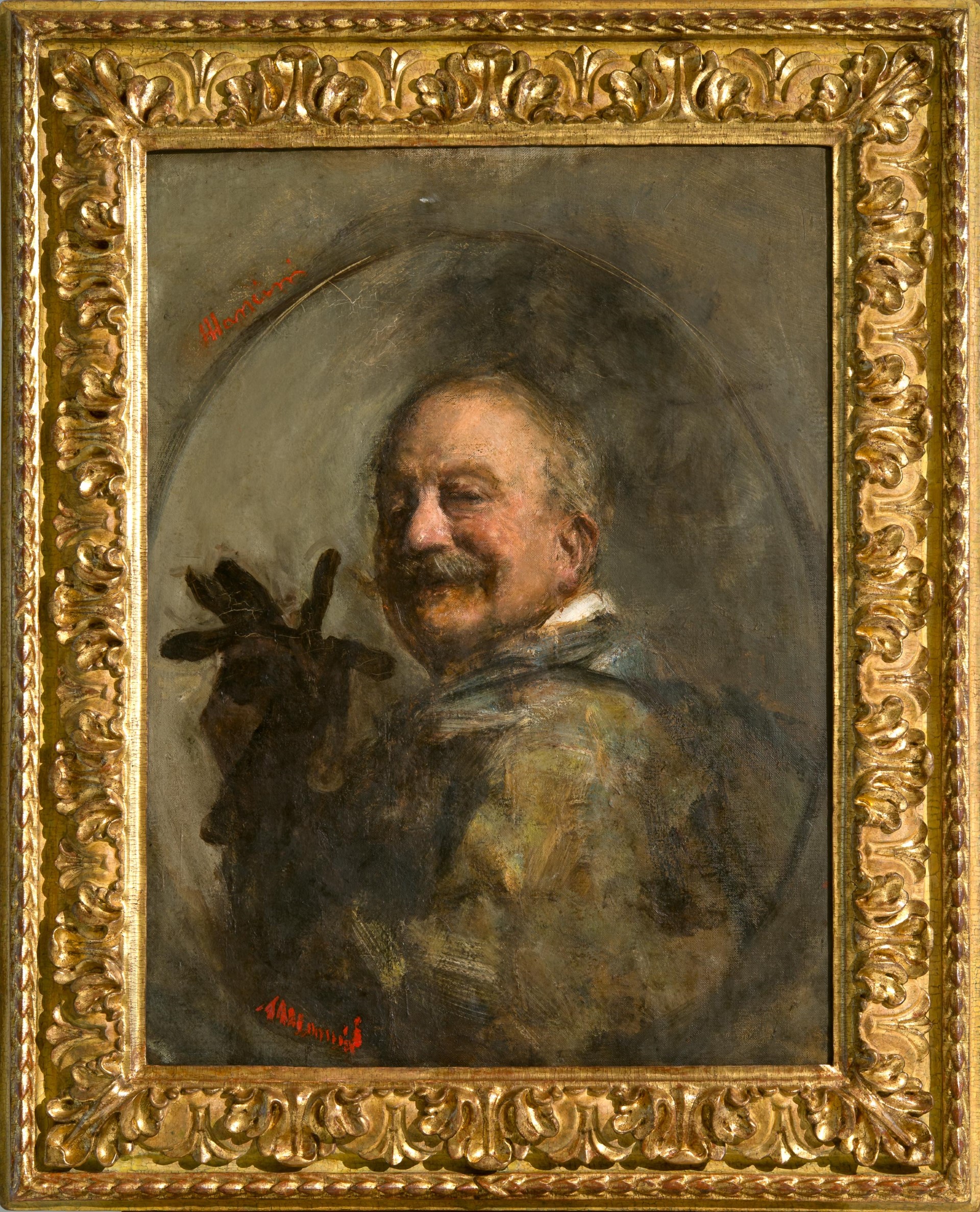Antonio Mancini - Self-portrait with black gloves - GAM Modern Art Gallery

Antonio Mancini - Self-portrait with gloves
A new acquisition for the Gallery of Modern Art in Milan: Self-portrait with black gloves by Antonio Mancini
Antonio Mancini
Rome 1852 – Rome 1930
Self-Portrait with Black Gloves (Self-Portrait with Glove)
Oil on canvas, 91 x 72 cm
Signed twice, top left and bottom left “A. Left-handed"
Loan from the Lombardy Regional Museums Directorate
provenance:
Fernand Du Chène de Vère; Clementina Pignatelli, born Du Chène de Vère; Pignatelli collection; private collection.
The painting depicts a half-length self-portrait of Mancini at the age of around sixty, the smiling three-quarter face turned towards the observer while the bust is in profile. He is holding a black glove, which gives the painting its title and stands out against the neutral gray background. The figure is inscribed inside an oval, which does not correspond to the shape of the frame, perhaps not original.
On the back the canvas presents a figure of a young man portrayed half-length and in profile, observing an object which he lifts with his hands. The painting on this verse, although at an advanced stage of development, appears not to have been finished.
Born in Rome, Mancini trained mainly in Naples, where the family had moved in 1865. Here he entered the Institute of Fine Arts in the same year, obtaining his first early recognition and coming into contact with Domenico Morelli – professor of painting since 1868 – which had a fundamental role in his formation. Although far from the historicist themes of the master, Mancini derived a painting based on formal values and technical virtuosity. Morelli directed Mancini to study the great tradition of the seventeenth-century Neapolitan tradition, which would constitute a constant reference for all of his production and from which the painter assimilated the lesson of a human and vibrant naturalism. From his first works Mancini in fact rejected academic themes and solutions, to turn his gaze to the popular reality that surrounded him, preferring to draw his subjects from the humanity of the streets and alleys of the Neapolitan city. In recent years a gallery of young street urchins, acrobats and street kids was born, portrayed with a realism alien to any social denunciation but full of human and psychological participation, rendered with a contrasting palette and a moving brushstroke, which were noticed by critics and ensured the first commissions. In 1871 he met the Belgian musician Albert Cahen, who became his patron and privileged client, inaugurating a typology of patronage relationships with collectors - especially foreign ones - which would characterize his entire career. It was Cahen who introduced him to the world of the Paris Salons, where Mancini went for the first time in 1875, obtaining a contract with the famous Maison Goupil. The difficult years in Paris, which will also be the cause of the end of the friendship with Vincenzo Gemito, whom he met during his formative years, do not stop the theory of important clients. In 1885 he met Hendrik Willem Mesdag, his collector, patron and main intermediary with Dutch clients (in whose collection, preserved in the museum of the same name in The Hague, numerous masterpieces by the painter are preserved); in 1883 the Marquis Giorgio Capranica del Grillo, who introduced him to international collectors and artists resident or passing through Rome, such as Hugh Lane, director of the Municipal Museum of Dublin, who became his admirer and patron (which is why the Irish museum preserves numerous works by Mancini). In 1908 it was the turn of the Prussian merchant Otto Messinger, who directed him towards neo-eighteenth-century subjects. With eight works commissioned by Messinger Mancini participated in the International Exhibition of Rome in 1911, achieving great success and the first prize for painting. On this occasion he was noticed by someone who would soon become one of his most important supporters and patrons, to whose story the painting in question is linked.
The Self-Portrait with the Glove is in fact the first work purchased by Fernand du Chène de Vère, a rich French industrialist who moved to Milan, who replaced Messinger, with whom the relationship had broken off, offering the painter an exclusive contract renewed annually from 1912 and giving him Villa Jacobini in Frascati is available (Cecchi 1966, p. 251; Virno 2019, p. 375). The work must be dated to 1910 and therefore belongs to a moment of reached expressive maturity and international recognition: the Portrait of Giorgio Capranica del Grillo and the Portrait of Mrs. Pantaleoni were awarded respectively at the Universal Exhibition of Saint Louis in 1904 and at the international one of Munich in 1905, the aforementioned Roman award in 1911 and in 1913 Mancini was named Academician of Merit of San Luca.
The painting portrays an artist aware of his own value but alien to any self-celebratory desire, and condenses some elements and themes that run through Mancini's entire activity. First of all, it is an important piece in the very long gallery of self-portraits created by the author, who in a true obsession portrayed himself in an incredible number of paintings, from his early years to his old age, so much so that he could consider the genre as a tool of analysis, which in fact seems to intensify in the dramatic months, between 1881 and 1882, in which Mancini is locked up in a mental hospital; in 1929, when he was among the first to be welcomed into the Royal Academy of Italy, he executed a Self-portrait (private collection) on which he noted the main scansions of his professional and existential path, while among the last works painted before his death there was a self-portrait (Self-portrait with a red turban, private collection). Here Mancini seems to give an unusually serene portrait of himself, characterized by a serene smile; another theme, that of laughter in all its facets, from joy to madness, which marks his entire work. Characterized by a liquid and moving application, far from the material richness of other contemporary works, the canvas shows echoes of the seventeenth-century Neapolitan tradition and proposes recurring Mancinian iconographic details, such as the black glove, whose shapeless silhouette stands out on the background almost like a disturbing shadow, elements present in an early masterpiece such as Dopo il duello (Turin, Galleria d'Arte Moderna).
The figure on the back, of a completely different inspiration, finds comparisons in numerous figures intent on observing objects of Mancini's painting, but has a particular point of interest in its execution technique, highlighted by its unfinished state. From the end of the ninth decade of the nineteenth century, Mancini began, in fact, to use the gridiron system in an increasingly conscious manner, consisting of two frames with squared string, placed one in front of the model and one in front of the canvas, the it is left visible on the painting, as can be seen very well in the work in question. This technique, initially appreciated by critics and later stigmatised, was widely described by the artist himself in numerous notes, in addition to the various testimonies of those who frequented his studio and dealt with his painting (see L. Cecchi Pieraccini, Lo studio di Antonio Mancini, in “Art Club”, December 1962, pp. 36-40).
From Fernand Du Chène de Vère, the painting passed into the ownership of his daughter Clementina (known as Tina), who married Prince Diego Pignatelli of Terranova. The historical labels on the back of the frame bear witness to its belonging to the Pignatelli collection.
Omar Cucciniello
Conservator Gallery of Modern Art Milan
Bibliography:
F. Geraci, One hundred and five works by Antonio Mancini, in “Corriere Padano”, 20 April 1940;
CE Oppo, Nineteenth century pictorial. Antonio Mancini, in “Frontespizio”, XII, 1940, ill. p. 456;
E. Zanzi, in 105 works by Antonio Mancini. Commemorative exhibition under the auspices of the Royal Academy of Italy on the tenth anniversary of his death, exhibition catalog (Turin, March 1940), Turin, 1940, p. 24 no. 96, ill. cover;
A. Schettini, Mancini, Naples, Stiped, 1953, p. 230;
F. Bellonzi, C. Lorenzetti, in Antonio Mancini, exhibition catalog (Milan, Gallery of Modern Art), Milan, Martello, 1962, p. 38 n. 55, tab. LV;
History of nineteenth-century Italian painting, Milan, Bramante, 1975, I, p. 194;
C. Virno, Antonio Mancini. Catalog raisonné of the work. Oil painting, Rome, De Luca, 2019, p. 375 n. 648.
Information
The work has become part of the visit itinerary and therefore does not require the payment of a supplement on the price of the museum entrance ticket.
